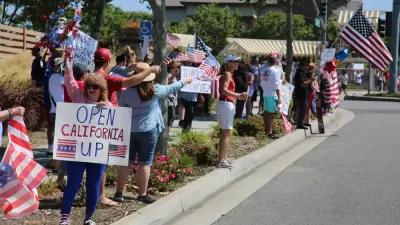While not conclusive, evidence suggests that relatively few transmissions of the coronavirus occurred during the widespread protests that followed the death of George Floyd due to the outdoor settings, being in motion and wearing of masks.

"Now, some public health officials and disease trackers say there appears to be scant evidence the protests sparked widespread outbreaks," reports "Others say that because many states reopened about the same time as the protests, and because of the limits of contact tracing, they simply can’t say for sure."
In other cities, officials were less willing to dismiss the potential role of the demonstrations. Other activities and events are also recognized as contributing to the surge.
On the other hand, actual documentation exists for what are called superspreading events or activities that are largely indoors, such as a church choir practice in Skagit County, Washington, events at a synagogue in New Rochelle, N.Y. and a cult church in Daegu, South Korea.
“While outdoor transmission is certainly possible, it does seem like it happens less frequently and that’s one of the reasons why: Your exposure is going to be higher indoors,” said Angela L. Rasmussen, a virologist at Columbia University.
Related in Planetizen:
- COVID's New Demographic, June 29, 2020
FULL STORY: Protests probably didn’t lead to coronavirus spikes, but it’s hard to know for sure

Maui's Vacation Rental Debate Turns Ugly
Verbal attacks, misinformation campaigns and fistfights plague a high-stakes debate to convert thousands of vacation rentals into long-term housing.

Planetizen Federal Action Tracker
A weekly monitor of how Trump’s orders and actions are impacting planners and planning in America.

San Francisco Suspends Traffic Calming Amidst Record Deaths
Citing “a challenging fiscal landscape,” the city will cease the program on the heels of 42 traffic deaths, including 24 pedestrians.

Defunct Pittsburgh Power Plant to Become Residential Tower
A decommissioned steam heat plant will be redeveloped into almost 100 affordable housing units.

Trump Prompts Restructuring of Transportation Research Board in “Unprecedented Overreach”
The TRB has eliminated more than half of its committees including those focused on climate, equity, and cities.

Amtrak Rolls Out New Orleans to Alabama “Mardi Gras” Train
The new service will operate morning and evening departures between Mobile and New Orleans.
Urban Design for Planners 1: Software Tools
This six-course series explores essential urban design concepts using open source software and equips planners with the tools they need to participate fully in the urban design process.
Planning for Universal Design
Learn the tools for implementing Universal Design in planning regulations.
Heyer Gruel & Associates PA
JM Goldson LLC
Custer County Colorado
City of Camden Redevelopment Agency
City of Astoria
Transportation Research & Education Center (TREC) at Portland State University
Jefferson Parish Government
Camden Redevelopment Agency
City of Claremont





























